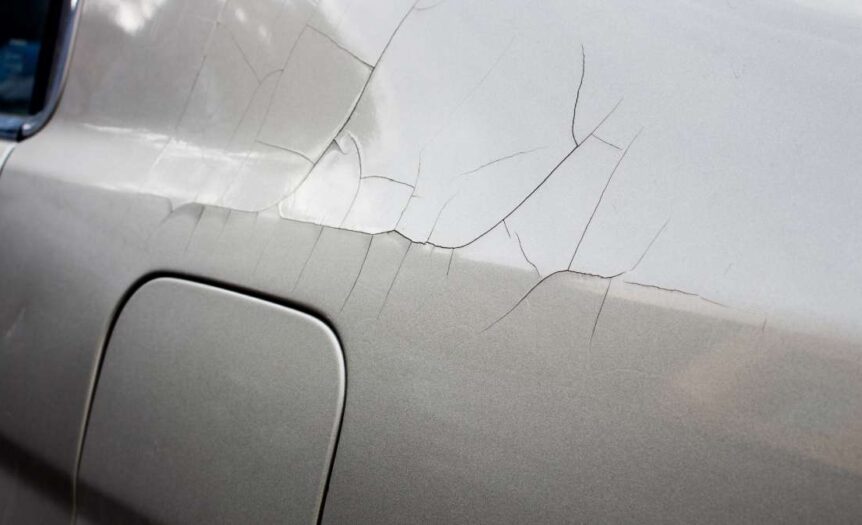Car paint issues are often the result of environmental factors wreaking havoc on your vehicle’s appearance. Understanding why your car paint is cracking and peeling is the first step toward prevention. Explore the reasons for these problems and some practical advice to help you protect your car’s finish.
1. Lack of Maintenance
Regular maintenance is crucial for preserving your car’s paint. Neglecting car washes and waxing can lead to the accumulation of dirt, grime, and pollutants on your vehicle, which degrades the paint over time. Regular cleaning removes harmful substances that eat away at your car’s finish, while waxing adds a protective layer against environmental elements, such as precipitation. Make it a habit to wash your vehicle at least once a month and wax it every three months to keep the paint looking fresh.
2. Sun Damage
Florida’s intense sunlight is a major culprit in the deterioration of car paint. The constant exposure to UV rays is one of the top sources of damage to your car’s paint, leading to fading, cracking, and eventually peeling. Protect your vehicle by parking in shaded areas whenever possible or investing in a quality car cover. Apply a UV-protectant wax to reduce the harmful effects of sunlight on your vehicle’s paint.
3. Humidity and Salty Air
Florida’s humid and salty air is highly corrosive to automotive exteriors, especially if you live close to the ocean. The salt crystals settle on the paint’s surface, attracting moisture and leading to oxidation and rust.
Rinse your car with fresh water regularly to remove salt deposits, especially after driving near the ocean or through rain. Also, thoroughly wipe your car with a dry towel to prevent excess moisture from settling on the surface.
4. Poor Quality Paint or Application
Using low-quality paint or improper application techniques leads to premature peeling and cracking. If you’re repainting your car, ensure the paint is high quality and suitable for your climate. Thinning automotive paint is important before applying because thick paint leads to issues during drying. It’s also worth investing in professional application services to guarantee correct and even application, reducing the likelihood of future issues.
5. Road Debris and Environmental Factors
Everyday road debris, such as small rocks and gravel, chip away at your car’s paint, while tree sap and bird droppings are surprisingly destructive if not cleaned off promptly. These elements create tiny scratches or chemical reactions that weaken the paint’s integrity. Moisture on the surface of your vehicle may get underneath the coating and cause cracking and peeling. Regularly inspect your car for debris or droppings and clean them off immediately to prevent long-term damage.
While your car’s paint cracks and peels for many reasons, regular care and attention mitigate these issues. Protect your investment by cleaning it consistently, using protective products, and addressing paint concerns promptly. By taking these steps, you’ll keep your car looking its best and avoid costly repairs.










 Deering Estate
Deering Estate
 Massage Envy South Miami
Massage Envy South Miami
 Calla Blow Dry
Calla Blow Dry
 My Derma Clinic
My Derma Clinic
 Sushi Maki
Sushi Maki
 Sports Grill
Sports Grill
 The Healthy Kitchen
The Healthy Kitchen
 Golden Rule Seafood
Golden Rule Seafood
 Malanga Cuban Café
Malanga Cuban Café

 Kathleen Ballard
Kathleen Ballard
 Panter, Panter & Sampedro
Panter, Panter & Sampedro
 Vintage Liquors
Vintage Liquors
 The Dog from Ipanema
The Dog from Ipanema
 Rubinstein Family Chiropractic
Rubinstein Family Chiropractic
 Your Pet’s Best
Your Pet’s Best
 Indigo Republic
Indigo Republic




 ATR Luxury Homes
ATR Luxury Homes


 2112 Design Studio
2112 Design Studio
 Hamilton Fox & Company
Hamilton Fox & Company
 Creative Design Services
Creative Design Services
 Best Pest Professionals
Best Pest Professionals
 HD Tree Services
HD Tree Services
 Trinity Air Conditioning Company
Trinity Air Conditioning Company
 Cisca Construction & Development
Cisca Construction & Development
 Mosquito Joe
Mosquito Joe
 Cutler Bay Solar Solutions
Cutler Bay Solar Solutions


 Miami Royal Ballet & Dance
Miami Royal Ballet & Dance
 Christopher Columbus
Christopher Columbus
 Pineview Preschools
Pineview Preschools
 Westminster
Westminster
 Carrollton
Carrollton
 Lil’ Jungle
Lil’ Jungle
 Frost Science Museum
Frost Science Museum
 Palmer Trinity School
Palmer Trinity School
 South Florida Music
South Florida Music
 Pinecrest Orthodontics
Pinecrest Orthodontics
 Dr. Bob Pediatric Dentist
Dr. Bob Pediatric Dentist
 d.pediatrics
d.pediatrics
 South Miami Women’s Health
South Miami Women’s Health

 The Spot Barbershop
The Spot Barbershop
 My Derma Clinic
My Derma Clinic




 Miami Dance Project
Miami Dance Project

 Rubinstein Family Chiropractic
Rubinstein Family Chiropractic
 Indigo Republic
Indigo Republic

 Safes Universe
Safes Universe
 Vintage Liquors
Vintage Liquors
 Evenings Delight
Evenings Delight





 Atchana’s Homegrown Thai
Atchana’s Homegrown Thai
 Baptist Health South Florida
Baptist Health South Florida

 Laser Eye Center of Miami
Laser Eye Center of Miami
 Visiting Angels
Visiting Angels
 OpusCare of South Florida
OpusCare of South Florida

 Your Pet’s Best
Your Pet’s Best





 HD Tree Services
HD Tree Services
 Hamilton Fox & Company
Hamilton Fox & Company


 Creative Design Services
Creative Design Services